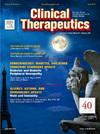乌达帕替尼对严重特应性皮炎儿童的药代动力学、安全性、耐受性和探索性疗效
IF 3.2
4区 医学
Q2 PHARMACOLOGY & PHARMACY
引用次数: 0
摘要
目的:本研究旨在描述已获批用于治疗成人和青少年中度至重度特应性皮炎(AD)的口服 Janus 激酶抑制剂 upadacitinib 在重度 AD 儿童中的药代动力学、安全性、耐受性和探索性疗效:在一项开放标签、多剂量的1期研究中,两个年龄组(2岁至6岁)的严重特应性皮炎儿童患者参加了研究:共有35名患者入组并接受了达达替尼治疗。IR口服溶液和ER片剂分别在0.5至2小时和2至2.5小时内达到最高达帕他替尼血浆浓度。与ER片剂相比,IR口服溶液剂的奥达替尼功能半衰期普遍较短。参与本研究的儿童患者的奥达替尼表观口服清除率随体重下降而降低。乌达帕替尼总体上安全且耐受性良好。最常见(≥3例)的不良反应为上呼吸道感染、COVID-19感染、头痛、腹部不适、呕吐、哮喘和咳嗽。与已知的奥达替尼在成人和青少年中的安全性相比,未发现新的安全性风险。在第12周获得探索性疗效数据的30例患者中,36.7%的患者经验证的AD研究者全球评估量表评分为0或1分(经验证的AD研究者全球评估0/1分),70.0%的患者湿疹面积和严重程度指数(EASI)至少改善了75%(EASI 75):本研究的药代动力学特征以及观察到的安全性和探索性疗效结果,支持在未来针对AD患儿的确证性3期临床试验中进一步研究目前的upadacitinib给药方案:NCT03646604,注册时间:2018-08-23。本文章由计算机程序翻译,如有差异,请以英文原文为准。
Pharmacokinetics, Safety, Tolerability, and Exploratory Efficacy of Upadacitinib in Children with Severe Atopic Dermatitis
Purpose
This study aims to characterize the pharmacokinetics, safety, tolerability, and exploratory efficacy of upadacitinib, an oral Janus kinase inhibitor approved for treating moderate to severe atopic dermatitis (AD) in adults and adolescents, in children with severe AD.
Methods
In an open-label, multiple-dose, Phase 1 study, pediatric patients with severe AD from two age groups (2 to <6 years and 6 to <12 years) received bodyweight-based dosing regimens of upadacitinib using either twice-daily immediate-release (IR) oral solution or once-daily extended-release (ER) tablets. A pharmacokinetic assessment was conducted on Day 7 of the study, which was followed by a long-term safety and exploratory efficacy evaluation for up to 108 weeks. The results reported here are based on an interim analysis when the study had completed enrollment and pharmacokinetic assessment.
Findings
A total of 35 patients were enrolled and received upadacitinib. The maximum upadacitinib plasma concentration was attained within a median time of 0.5 to 2 hours and 2 to 2.5 hours for the IR oral solution and ER tablet formulations, respectively. Upadacitinib functional half-life was generally shorter with IR oral solution relative to ER tablets. Upadacitinib apparent oral clearance decreased with decreasing body weight in the pediatric patients enrolled in this study. Upadacitinib was generally safe and well tolerated. The most common (≥3 patients) adverse events were upper respiratory tract infection, COVID-19 infection, headache, abdominal discomfort, vomiting, asthma, and cough. No new safety risks were identified compared to the known safety profile for upadacitinib in adults and adolescents. In the 30 patients with available exploratory efficacy data at Week 12, 36.7% achieved validated Investigator's Global Assessment scale for AD score of 0 or 1 (Validated Investigator Global Assessment for AD 0/1), and 70.0% had Eczema Area and Severity Index (EASI) improvement of at least 75% (EASI 75).
Implications
The characterized pharmacokinetic profiles in this study, together with the observed safety and exploratory efficacy results, support further investigation of the current upadacitinib dosing regimen in future confirmatory Phase 3 clinical trials in children with AD.
Clinical Trial Number: NCT03646604, registered 2018-08-23
求助全文
通过发布文献求助,成功后即可免费获取论文全文。
去求助
来源期刊

Clinical therapeutics
医学-药学
CiteScore
6.00
自引率
3.10%
发文量
154
审稿时长
9 weeks
期刊介绍:
Clinical Therapeutics provides peer-reviewed, rapid publication of recent developments in drug and other therapies as well as in diagnostics, pharmacoeconomics, health policy, treatment outcomes, and innovations in drug and biologics research. In addition Clinical Therapeutics features updates on specific topics collated by expert Topic Editors. Clinical Therapeutics is read by a large international audience of scientists and clinicians in a variety of research, academic, and clinical practice settings. Articles are indexed by all major biomedical abstracting databases.
 求助内容:
求助内容: 应助结果提醒方式:
应助结果提醒方式:


